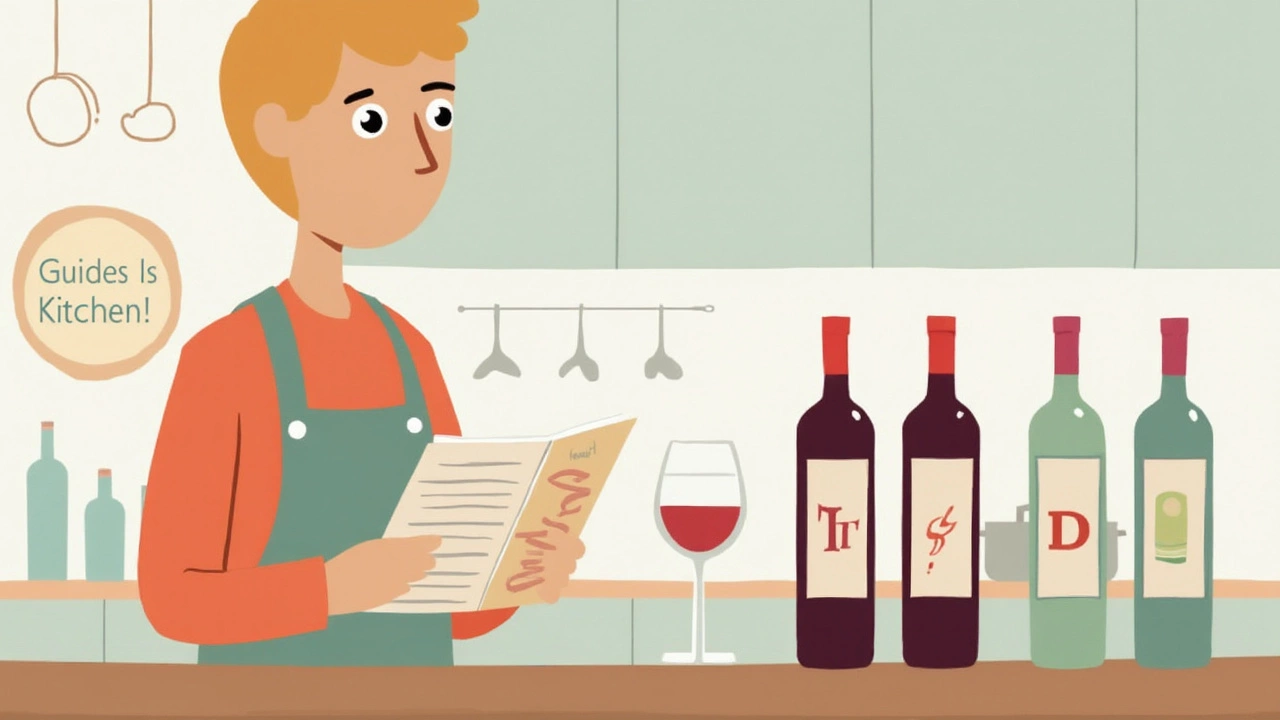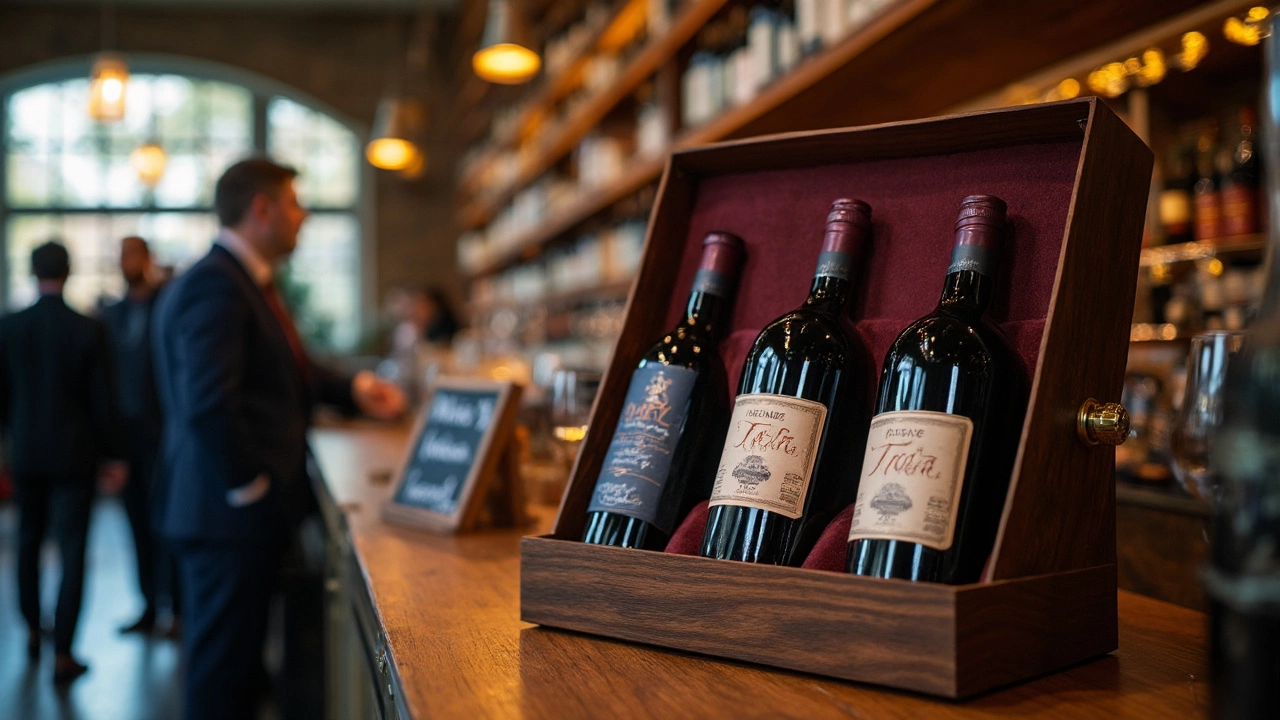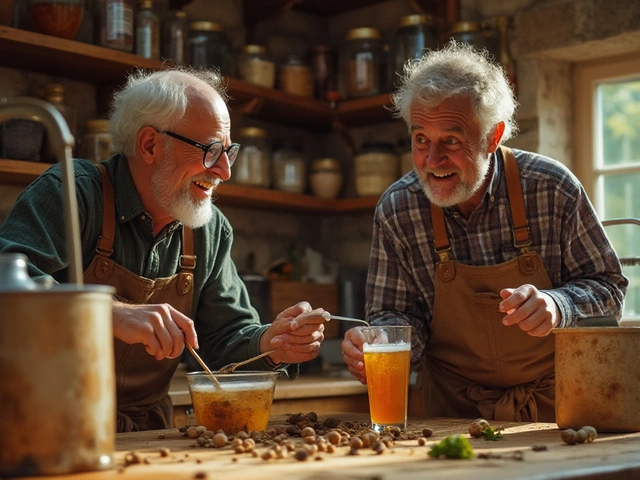If you're eyeing three bottles of wine, maybe for a dinner party or just a weekend with friends, you might wonder if there's a fancy name for that—like a 'case' for twelve or 'magnum' for a big bottle. But here's the straight answer: there isn't a classic, official term in wine lingo for three bottles. Sometimes you'll hear 'trio' tossed around, especially on wine club websites or in tasting rooms, but that's more marketing than tradition.
Wine pros and drinkers usually just say 'three bottles.' No need to impress anyone with mystery jargon—they'll just ask you what bottles you brought. That said, wineries love creating special three-bottle bundles, giving them catchy names or lining them up as themed packs. It's a neat trick for anyone wanting a tasting flight at home, and a trio actually gives a much rounder picture of a winery’s style than grabbing a single bottle.
- Is There a Name for 3 Bottles of Wine?
- How Restaurants and Stores Bundle Wine
- Wine Lover’s Packs: Why the Trio Works
- Tips for Tasting a Wine Trio Like a Pro
- How Much Wine Do You Actually Need?
Is There a Name for 3 Bottles of Wine?
You’ve probably heard wine insiders tossing around names for big groupings—case, half-case, magnum, double magnum. But when it comes to just three bottles, there isn’t an official word in the wine world. No grand French term, no cool shorthand. A lot of folks just say "wine trio," but that’s not a traditional phrase—it mostly pops up in wine clubs or gift packs because it sounds good for sales.
Here’s how wine bottle groupings usually shake out:
- Single bottle: Just one, nothing fancy.
- Half-case: 6 bottles.
- Case: 12 bottles (the standard for bulk purchase).
You might see names for extra-large single bottles—like Magnum (1.5 liters, or 2 bottles), Jeroboam (3 liters, or 4 bottles)—but not for sets of regular bottles lower than half a case.
Some wine producers or shops will label a set of three as a "trio" or "wine flight" for themed tastings. This is more about marketing than tradition. You might get three Pinot Noirs from different years, or a red, white, and rosé from the same winery, bundled for customers who want to try more than one without committing to a whole case.
If you’re hanging out with wine geeks or pros, just calling it "three bottles" is totally normal. You won’t earn any style points trying to invent a term. The real action is all about what’s in the bottles, not what you call the set.
| Name | Number of Bottles |
|---|---|
| Single | 1 |
| Half-Case | 6 |
| Case | 12 |
| Trio (Marketing Term) | 3 |
When shopping or planning tastings, don’t sweat the terminology. People care more about the wine itself than whether your set has a special name. If you want to bundle three bottles to explore or share, just call it a "3 bottles of wine" or go with “trio” if you want a bit of style on the invite.
How Restaurants and Stores Bundle Wine
Ever seen "three for the price of two" or "wine trio" deals at your local shop? That's no accident. While the wine world doesn't have an old-school term for 3 bottles of wine, the retail side knows there’s real power in selling things in sets of three.
Most U.S. wine shops and restaurants arrange bottles into bundles to make picking easier and to move more product. According to Wine Market Council’s 2024 survey, nearly 40% of wine consumers say they're more likely to try a new wine if it comes in a bundle deal. This works especially well for people who want to explore, compare, or just stock up. These trio packs might be built around a theme—like “Italian Reds,” “Women Winemakers,” or three different vintages from the same vineyard.
Some places even push wine flights—where you get three smaller pours, not full bottles, but same idea. It’s all about discovery and comparison. Emily Wines, Master Sommelier, is on record saying,
"A well-chosen trio tells a story better than a single bottle ever could. Restaurants get that—so do most wine shops."
Stores often put trio bundles right next to checkouts or under signs that make it easy for you to grab and go. Here are a few ways they're usually bundled:
- Same grape, different regions (like three Pinot Noirs from three countries)
- Vertical packs (same wine, different years for vintage comparison)
- Mixed party packs (a red, a white, a bubbly—ready for any dinner)
Ever wonder how discounts stack up? Here’s what a popular downtown wine shop offered last month:
| Deal | Regular Price | Bundle Price | You Save |
|---|---|---|---|
| 3 French Reds | $90 | $75 | $15 |
| 3-Mix Holiday Pack | $56 | $45 | $11 |
Wine clubs have also jumped on this, sending three bottles monthly. Some members even get to pick their bottles. It’s the same vibe with restaurant “wine flights” at the table—three glasses, three styles, one neat snapshot of a region or winery.

Wine Lover’s Packs: Why the Trio Works
There’s a reason you see wineries and online shops pushing trio packs all the time. Three bottles aren’t just a random grab—they’re kind of the sweet spot for home tasting. If you want to get to know a winemaker, or compare a region, three options let you actually spot differences without overwhelming you or your guests.
Most classic “flight” tastings use three wines for a reason: your palate can handle the variety, but you won’t lose focus or end up too tipsy. Big names in wine clubs (think Winc or Firstleaf) shape plenty of their monthly offers around this number, because people finish three bottles fast, but it’s enough to feel like a proper selection.
Here’s what makes a three-bottle set a smart move for wine lovers:
- 3 bottles of wine balance variety and practicality—a red, a white, and a rosé let you cover your bases for a meal, or compare styles from one spot.
- You can split three bottles between four to six people pretty comfortably. Each person gets a solid pour from each bottle.
- If storage or budget is tight, three bottles fit in the kitchen fridge or wine rack way easier than a whole case.
Some clubs and shops even put together themed trios to teach you something. For example, you might get a “Pinot Noir Around the World” trio, or a vertical flight (same wine, different years). These give you a cool crash course without needing a sommelier at your side.
| Trio Theme | What You Learn |
|---|---|
| Regional Sampler | How one grape changes with weather and soil |
| Same Wine, New Vintages | The effect of aging and yearly climate |
| Food Pairing Pack | Which wine plays best with your favorite dishes |
If you want something memorable for a tasting night, you honestly don’t need more than three options. It’s wallet-friendly and actually helps everyone pay attention. After a few glasses, even serious tasters start losing track of details, so sticking with a trio keeps the experience enjoyable and not overwhelming.
Tips for Tasting a Wine Trio Like a Pro
Thinking about lining up your 3 bottles of wine for a tasting? That’s the sweet spot for noticing real differences and impressing everyone at the table. Here’s how to get the best out of a trio, whether it’s your friends’ favorite reds or a mix you picked on a whim.
Start with this: Serve the wines in a logical order. Go lightest to boldest. For example, start with whites before moving to reds, or sip the youngest before the oldest. This keeps your taste buds sharp and helps you actually tell the wines apart.
- Temperature matters. Whites shine at 45–55°F (7–13°C), while reds usually open up best between 55–65°F (13–18°C). Let your reds warm up from the fridge or cool reds down if they’re too hot off the shelf.
- Glassware counts. Use the same style of glass for all three bottles. Keeps the playing field level—different shapes mess with the aroma and taste.
- Have a spittoon or glass of water handy. Swirling and spitting isn’t just for snobs. You’ll stay sharp when comparing wines if you’re not drinking full pours every time.
- Give each bottle a nickname. Seriously, friends remember 'The Spicy Red' or 'Crispy White' way more than they do a French label or year.
If you want a real side-by-side, pour all three glasses at once and sniff them before you taste. You’ll be surprised how clearly you can sense the differences this way.
Don’t forget snacks. Good bread, a wedge of cheese, or some plain crackers will clean your palate between sips. Avoid spicy or very sweet foods—they mess with your senses.
| Bottle Size | Glasses per Bottle | Total Glasses (3 Bottles) |
|---|---|---|
| 750ml | 5 | 15 |
| 375ml (Half) | 2 | 6 |
| 1.5L (Magnum) | 10 | 30 |
Jot down a few notes or vote for a favorite at the end. You’ll remember what you loved next time you shop. Tasting three back-to-back gives you context—suddenly, subtle flavors pop out that you never noticed before when sipping just one bottle in isolation.

How Much Wine Do You Actually Need?
Let’s cut to the chase—how many bottles should you really open for a night in, a dinner party, or a tasting? The answer depends on headcount, how long you'll be hanging out, and whether wine is the main event or just one part of the meal.
If you’re hosting a tasting, those three bottles go a long way. Here’s the math: each standard bottle of wine is 750ml, which means you get about five regular glasses per bottle. A trio adds up to roughly 15 pours. If you’re pouring tasting-sized samples—say, two ounces—you’ll get about 12 tastes per bottle, so three bottles could fill up 36 tasting glasses. That easily covers 6–8 people if everyone wants to sample each bottle.
For a sit-down dinner, the old reliable rule is one bottle per two guests for a leisurely meal. So three bottles will nicely cover a dinner for six, even if your friends enjoy a refill or two. If wine is only for a toast or served with one course, you’ll likely have leftovers.
- For a dedicated wine night with four adults, three bottles is the sweet spot—plenty to try different styles, not so much that anyone overdoes it.
- Pairing food? Try a white, a red, and a wild card (like a rosé or sparkling) so everyone can find something they like.
- Bringing wine to a party? Three bottles show up better than a single bottle but don’t feel over-the-top.
Remember, wine keeps best if you store it upright, out of the sun, and even opened bottles can last a couple of days if you pop them in the fridge. If you’re unsure, go with three—hosting is easier and way more fun with enough wine to go around. And if someone asks what 3 bottles of wine is called, now you know how to handle it without sounding snobby.


